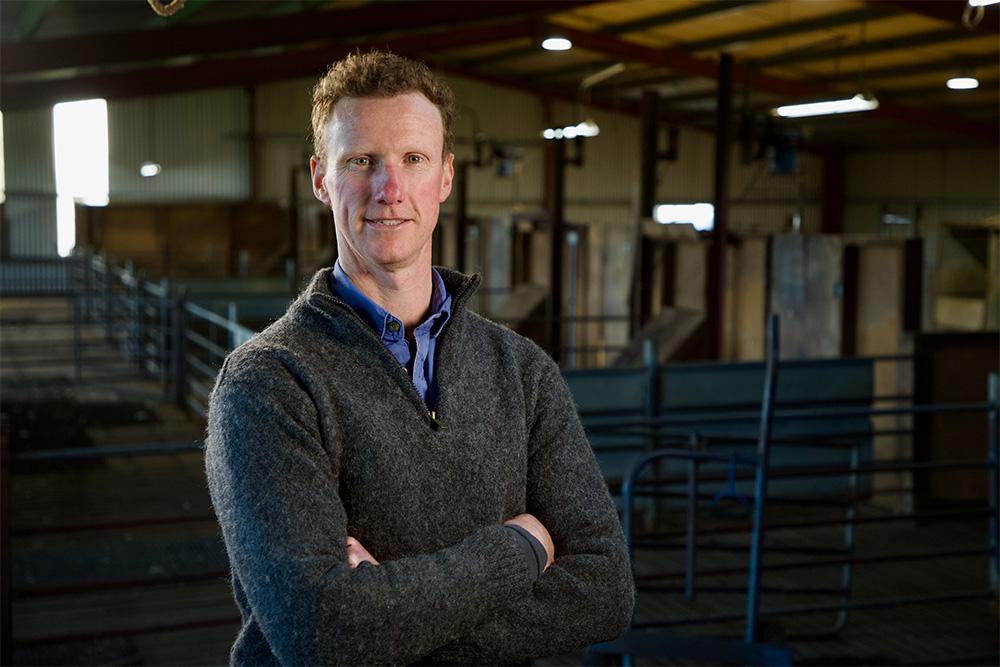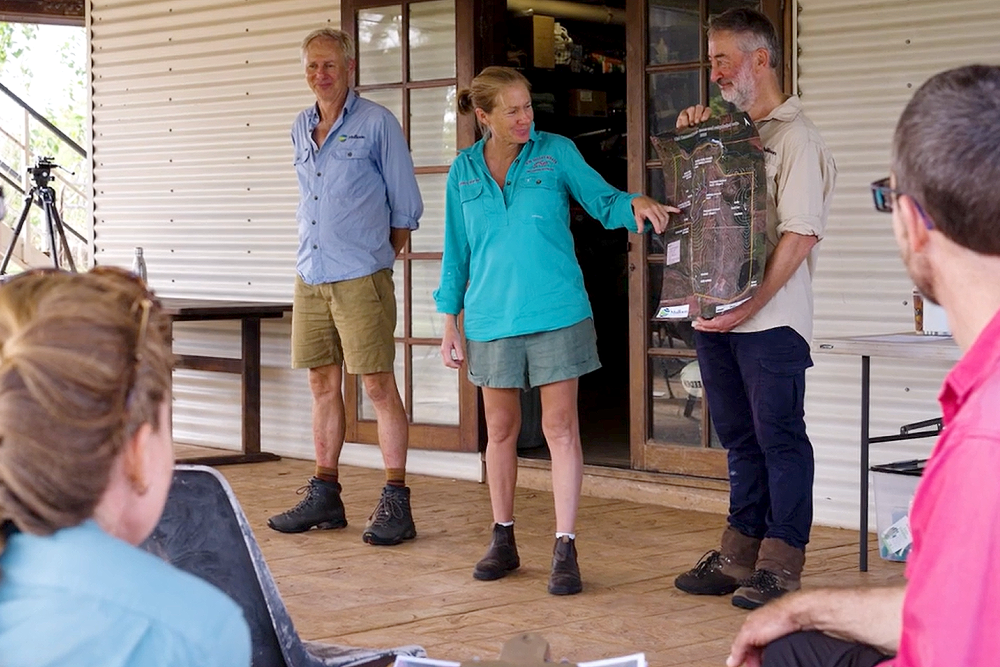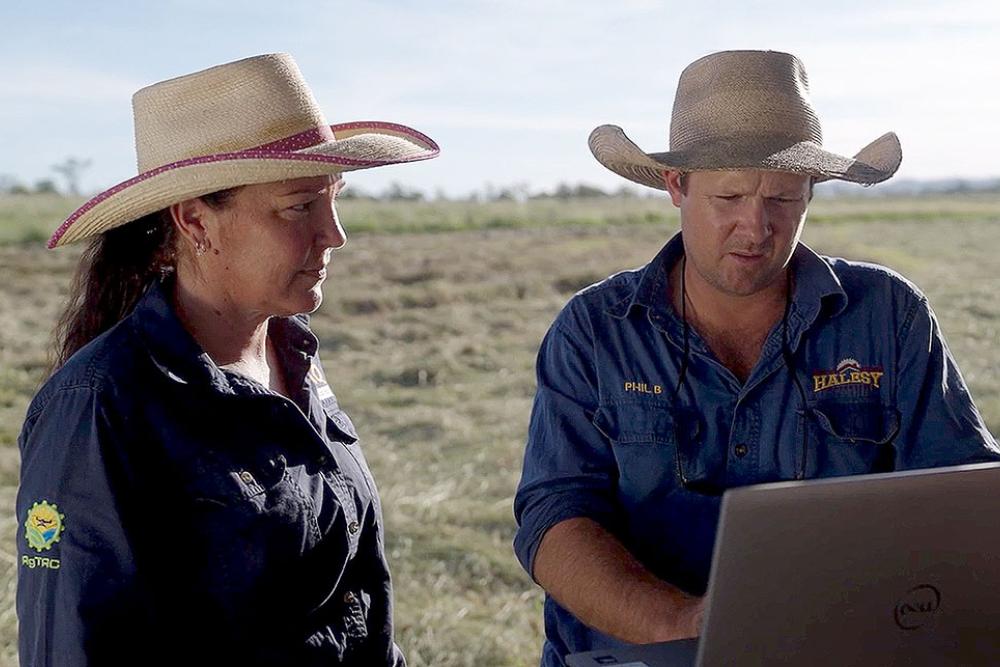Mixed cattle farmers Jake and Frankie Fennell run a 4,000-strong beef herd on their property Wintinna Station in Outback South Australia.
After the 2017-2019 drought, they embraced GPS cattle tracking tags and rotational grazing to better prepare their business for drought.
“We came across [the idea of] resting country in 2019 when it was really dry and it forced our hand to do it. We were running out of feed, so we had to build new paddocks,” Jake said.
Over time the Fennells saw how moving the cattle around these newer paddocks allowed smaller rain events to have a bigger impact.
“We had a few little rain events, say 10 or 12 millimetres, and the amount of growth that we saw while there were no cows in there, you’d think you’ve had 25 or 30 mil!”
But the cost of new infrastructure limited Jake and Frankie’s ability to further expand their more drought resilient grazing practice.
To help overcome some of the cost, the Fennells agreed to host a Future Drought Fund project led by SA Arid Lands Landscape Board under the Drought Resilience Soils and Landscapes Program.
Jake and Frankie now show other rangelands farmers how resting country means they can go two-years without rain and still maintain production and soil health.
“We think we’re cattle farmers,” Jake said. “But cattle farmers grow grass and grass comes from soil. So, you need to look after your soils first and go from there.”
Andrea Tschirner from SA Arid Lands said the goal of the project is to keep the rangelands cattle industry thriving as the climate changes.
“We really want to see businesses become more resilient in dryer times and we think a big component of that is maintaining vegetative cover,” Andrea said.
See how the Future Drought Fund is helping cattle farmers like Jake and Frankie build their drought resilience
Video duration 5 mins 43 secs
Introduction
This is the transcript of a video case study produced by the SA Arid Lands Landscape Board for a project funded by the Future Drought Fund.
Learn more about the Future Drought Fund’s Drought Resilient Soils and Landscapes Program.
Transcript
[Recording begins]
Frankie Fennell [0:15]:
I'm Francesca or Frankie Fellow, I'm at Wintinna Station which is in the far north of SA. We're two hours north of Coober Pedy and it's 3,812 square kilometres.
Jake Fennell [0:27]:
Jake Fennell at Wintinna Station, every breed you can imagine. We used to joke where every breed by Wagyu and then we bought some stud cows from Newcastle Waters and that gives us the Wagyu. So, [laughs] we pretty much have everything there is. We've got about 4,000 on the place there's about 2,700 breeders in there.
Frankie Fennell [0:46]:
The country on Wintinna is mixed because we've got the highway going through the middle. So, on the western side we've got Mulga sandhills and then it's like quite a heavier carrying country and that's where we'd like to run the majority of our breeders.
Jake Fennell [1:00]:
Our eastern side’s got a mix of like crap old country got a little bit of luck, like breakaway country—like real sweet country but doesn't carry many cattle.
Frankie Fennell [1:11]:
Favourite bit of technology we've got at the moment would be for Ceres tags. Basically like a solar powered GPS for your cow. So, you can see where they are, what they're doing, if they're following, the rainfall, how much time they're spending at a water point. From the data on the tags goes on the computer, you can see new waters that we didn't know were there before.
Out on our western side especially, where they're going after rain because they would disappear off water for months on end and we didn't know where they went. And now with the tag we can zoom in and say, ‘Oh, yeah, they're there!’.
Jake Fennell [1:46]:
With things like those Ceres tags or the virtual fencing tracking in them, if we can either congest them down with the fencing or use the tags just to locate where they are or know what area they're in before we start mastering—it saves loads of time. Like the few tags we've got in out there saved us a lot of time in the last master.
Andrea Tschirner [2:08]:
I'm Andrea Tschirner, I'm the Regional Agriculture Land Care Facilitator and I work in the South Australia Arid Lands region. Trying a few things, we're starting from the ground up. We're starting with the soils. So, one of the key things about soil science is that a lot of the energy gets focused in cropping areas and high rainfall areas, and we don't know as much about rangeland soils and there are so many soil types in pastoral country.
Jake Fennell [2:33]:
Through the ‘Ground Up’ project, we got some money to do soil and grass samples, like to get them analysed. Some of the results were really surprising. Like traditionally what's known as like your harder country, and not as good—it come back with more protein than like a good open Mitchell Grass country. And things like your phosphorus, we knew were deficient, but it was a lot worse than what we thought. We need to supplement more for that to get our production up. And, like, through these things we think we're cattle farmers. But cattle farmers grow grass and grass comes from soil. So, you need to look after your soils first and then go from there.
Andrea Tschirner [3:18]:
So, this project was born really with a grant though the Future Drought Fund—the Drought Resilient Soils and Landscapes Program. And it's enabling us to really test how rest-based grazing practices can be rolled out on large-scale pastoral properties. So, the trials we've got set up throughout South Australia we've got two intensive demonstration sites on Wintinna and on Buckleboo.
So the wider part of the funding program, we're looking at three main elements. The first and probably our key focus at the moment is establishing demonstration sites and having field days. So, getting people out on Country, looking at the way other people are practicing and managing their grazing with livestock including beef cattle industry participants but also Dorper and Merino shaping the southern part of South Australia's rangelands.
Jake Fennell [4:02]:
Look, we need 24 paddocks for the rotation. So, then our core herd could run as one rotation and then we have 24 months in the rotation which that'll give us two years we can allow for with no rain at all or no growth event in the grass. And then once that finishes, we'll still have one paddock spare as a drought reserve.
We come across resting country like after 2019 when it was really dry and it forced our hand to do it, like we were running out of feed. So, we had to develop new paddocks, like build new paddocks to put the cows in. And while we kept building these paddocks, ‘cos the herd was together, we'd run out of feed, then we'd have to move again.
And in that time, we had a few little rain events like 10 mil or 12 mil and the amount of growth that come up when there was no cows in there—you'd think you've had 25 or 30 mil. So, that's sort of promoted us in the idea of moving them around because you get a lot more effect from a smaller rainfall.
A lot of people rest country and move them around. But I think it's mainly the cost of infrastructure. And we found even with a few cattle in there, like it slows their growth down.
Andrea Tschirner [5:04]:
Ultimately, we want to see the pastoral industry continue to thrive in the rangelands. But improve ground cover and really maintain and better establish our perennial pasture species So, as we move into more unpredictable climate times. We really want to see businesses become more resilient in drier times and we think a big component of that is by maintaining vegetative cover in a lot of pastoral land.
[Recording ends]



